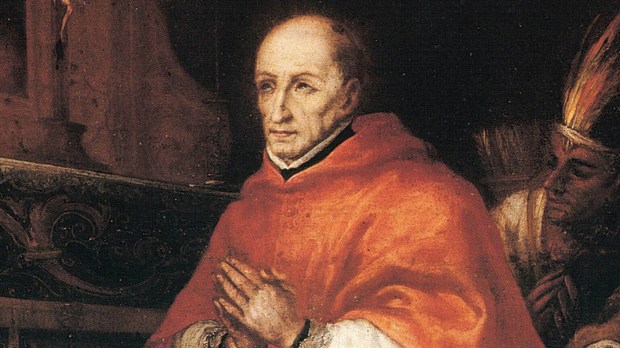This Archbishop is the Patron Saint of Latin American Bishops and native people’s rights.
Turibius Alfonso de Mongovejo was born in the Vallodolid province in Hapsburg, Spain, on November 16, 1538. His parents were nobles, Luis Alfonso de Mogrovejo and Ana de Robles Moran. Turibius had a sister who was named Grimanese.
Even as a pre-schooler, Turibius demonstrated pronounced piety. As he grew older, his devotion to the Blessed Mother increased, and before long, he was fasting once a week in her honor while also praying the Rosary daily. Since he had been born into nobility, he was able to enter the college at Vallodolid. He did this at the age of 12, and he immediately began studying the Humanities.
After finishing his studies, Turibius was given a position as a professor of law at the College in Salamanca. His uncle, Juan de Mogovejo, was a professor at the college and highly regarded. Soon after, King Juan III asked Turibius’ uncle to teach at the College of Coimbra. Uncle Juan accepted and took his nephew with him; Turibius simultaneously continued his studies while also teaching. Not long after, Uncle Juan died suddenly. The ordered life of Turibius of Mogrovejo was about to change dramatically.
King Philip II of Spain had been monitoring the abilities and character of Turibius. He decided to appoint the young man as the Grand Inquisitor on the Inquisition Court, which was stationed in Grenada. The year was 1571 and Turibius was only 33 years old. Many complained and raised concerns about the young man’s experience, but King Philip would not change his mind. He wanted Turibius.
Lima, Peru, was the second most important city in Spain’s Latin American empire. The most important was Mexico City. When the Archbishop of Lima died, the King immediately looked at his replacement options. He wanted someone he could count on. At the time, the arrangement was that the king could appoint a bishop, and the pope would give his approval. King Philip appointed Turibius to replace him.
There was one problem; Turibius was not a priest. He was a layperson and was shocked to hear that he had been appointed. He argued fiercely to be taken from consideration. The king refused to change his mind.
Turibius argued that canon law prohibited the king from even naming a bishop. His points were valid but the pope overruled him. In 1578, they fast-tracked his ordination and, after four weeks of intense study, he received Holy Orders. He said his first Mass when he was 41 years old.
On May 16, 1579, Pope Gregory XIII named him Archbishop of Lima. He received his episcopal consecration in August 1580 and, along with his sister and her husband, arrived in Lima in May of 1581.
Despite the offbeat trajectory, King Philip II had chosen well. Archbishop Turibius was extraordinarily dedicated and plunged into his mission filled with zeal and enthusiasm. He literally exhausted himself on year-long missions within the vast territory, visiting the priests and people in his care. He standardized sacramental, pastoral, and liturgical practices using synods he convened for that purpose. He even produced a trilingual catechism in Spanish and native dialects and learned to preach and speak in various tongues, allowing him to hear confessions and converse with the natives in their languages.
St. Turibius became ill on the way home from one of his extended journeys. He died far from home at the age of 67. Ironically, he had predicted the exact date and hour he would die and, indeed, that came to pass. He died on March 23, 1606. It was Holy Thursday, and the time, as predicted, was 3:30 p.m.
In his 24 years as archbishop, he baptized and confirmed half a million people. Among them were Martin de Porres, Francisco Solano, and Isabel Flores de Oliva, who all became saints. Isabel is more commonly known as Saint Rose of Lima.
The archbishop had traveled thousands of miles through the most challenging wilderness. He never missed offering Mass and he never accepted any personal gifts. He was canonized in 1726 and named the Patron Saint of Latin American Bishops by Pope St. John Paul II in 1983. He is also Patron to Lima, Peru and called on to intercede for the protection of the dignity of native peoples.
He is compared to the great Italian, St. Charles Borromeo,and in Querida Amazonia, Pope Francis’ post-synodal apostolic exhortation, the Holy Father praises his missionary zeal:
[T]he kerygma and fraternal charity constitute the great synthesis of the whole content of the Gospel, to be proclaimed unceasingly in the Amazon region. That is what shaped the lives of the great evangelizers of Latin America, like Saint Turibius of Mogrovejo or Saint Joseph of Anchieta.
St. Turibius de Mogovejo, pray for us.

